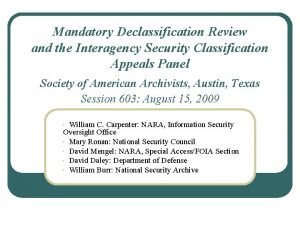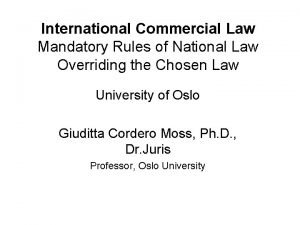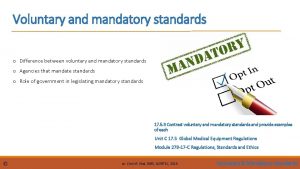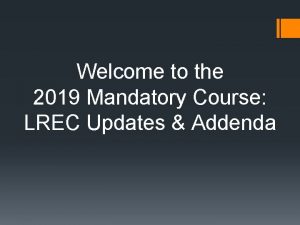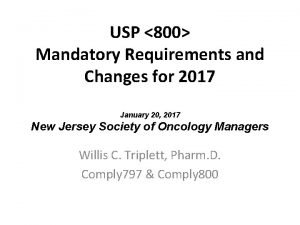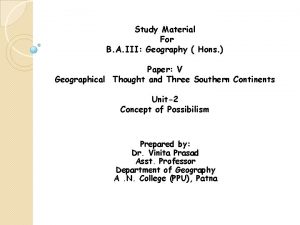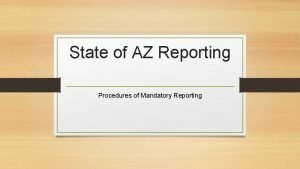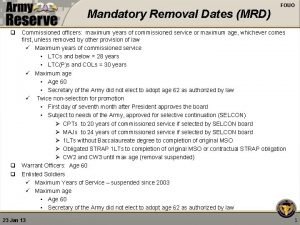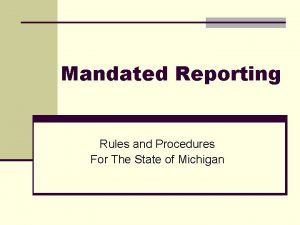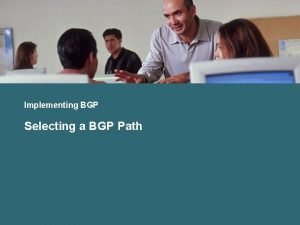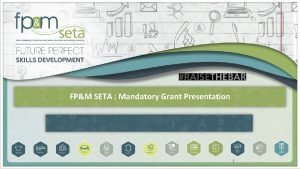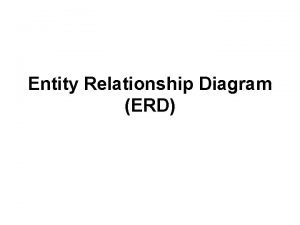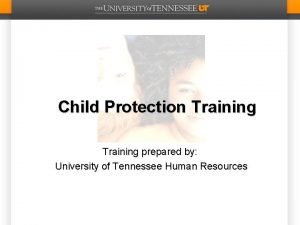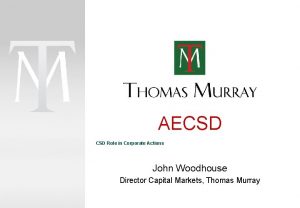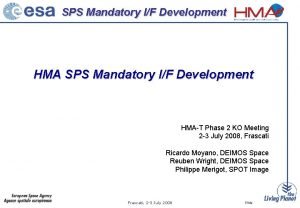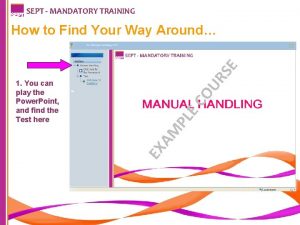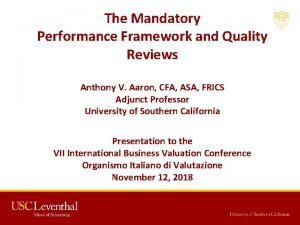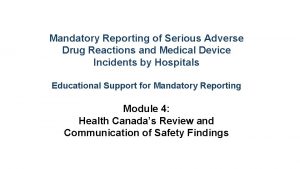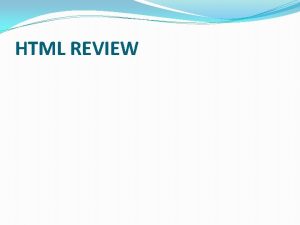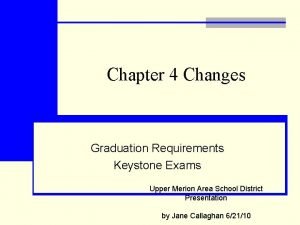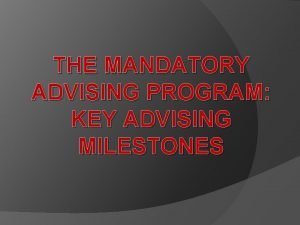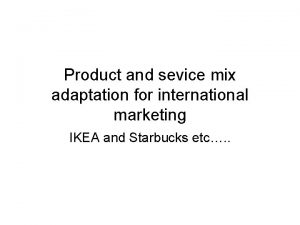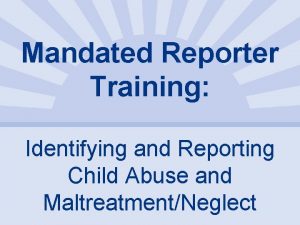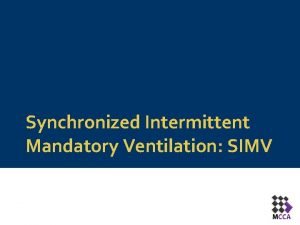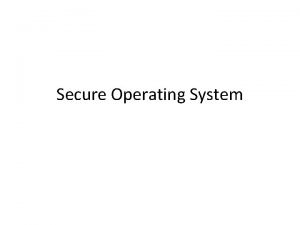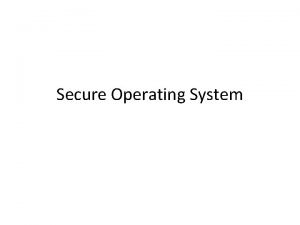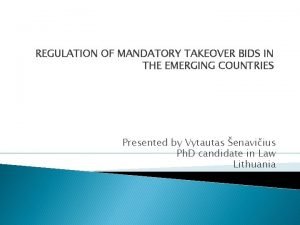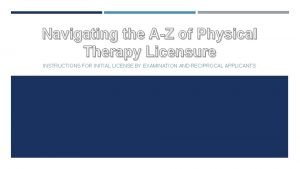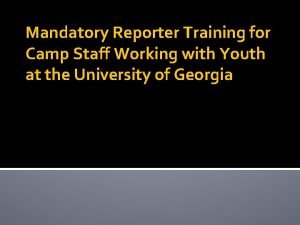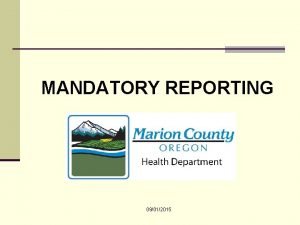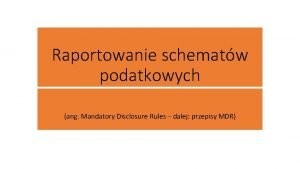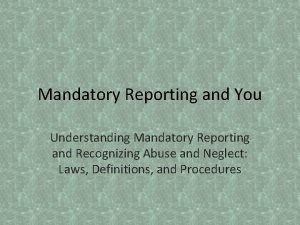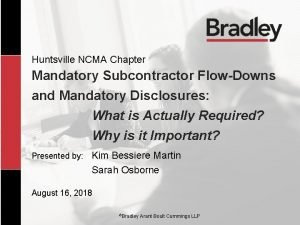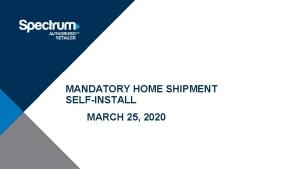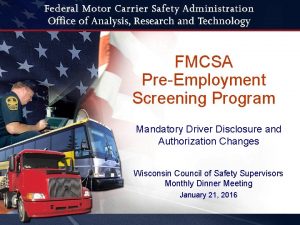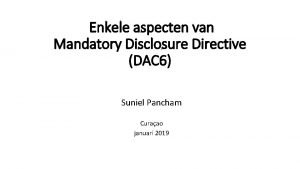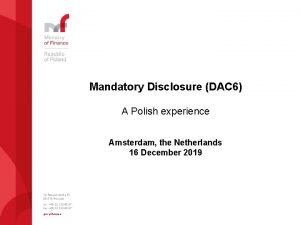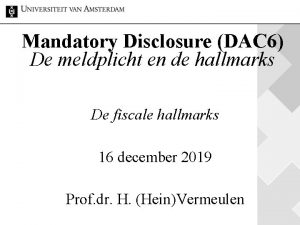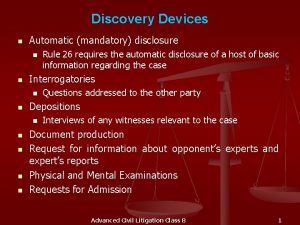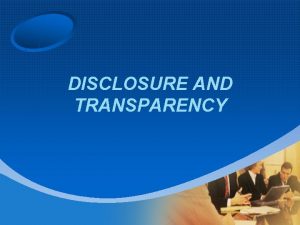Review of Disclosure Rules New Mandatory Disclosure and




































- Slides: 36

Review of Disclosure Rules – New Mandatory Disclosure and Existing Rules Carol Hogan Wednesday July 06 December 202027, 2011

Introduction • Mandatory disclosure is required for a scheme which is: – designed to give the tax payer a tax advantage; and – not a scheme that relies on ordinary tax planning using standard statutory exemptions and reliefs in a routine fashion for bona fide purposes, as intended by the legislature • Directed mainly at professional advisers who provide a tax service which Revenue regard as "aggressive“ • Follows international trend (e. g. UK DOTAS regime)

What Taxes? - All taxes, duties and levies - Includes excise duties - Not customs duties

Relevant legislation and documents a) The Taxes Consolidation Act 1997, Sections 817 D to 817 R b) The Mandatory Disclosure of Certain Transactions Regulations 2011 (SI No. 7 of 2011); and c) Guidance Notes on Mandatory Disclosure Regime issued by the Revenue in January 2011 – (a) and (b) above have force of Law – (c) above is Revenue’s view and has no legal status

Purpose of the Mandatory Disclosure Regime • To enable the Revenue to obtain information on: – tax schemes and how they work – who has availed of the tax schemes - To further enable the Revenue to – challenge the tax planning through anti-avoidance provisions, or – change the legislation

Who Must Disclose? • A person (a promoter) who in the course of business: – is responsible for the design of a tax scheme – has specified information about the tax scheme and makes a marketing contract – makes a scheme available for implementation by other persons; or – is to any extent responsible for organising or managing the implementation of a tax scheme TCA 1997 Section 817 D(1) Note: there may be more than 1 promoter.

Who Must Disclose? (contd) • Regulation 30 excludes from the definition of “Promoter” a person: – Who in the course of providing tax advice is not responsible for the design of the disclosable transaction (including the way in which the transaction is structured) – Is responsible for the design (including the way in which the transaction is structured) but does not provide tax advice; or – Is not responsible for design of all of the elements, could not reasonable be expected to have sufficient information to know whether the transaction is disclosable or to comply with the disclosure requirement.

Who Must Disclose? (contd) • According to Revenue Guidance Notes: “a promoter might consult a law firm (that operates a business that includes giving tax advice) in relation to the company law aspects of a scheme, or an accounting firm about the accounting aspects of a scheme. So long as the law or accounting firm does not provide tax advice (other than benign advice) it will not be treated as a promoter”

Who Must Disclose? (contd) • The user of an “in-house” scheme • The user of a foreign promoted scheme, • Where a promoter of a tax scheme has the benefit of legal privilege and asserts that legal privilege, the user must disclose the scheme, • If client waives legal privilege – onus back to advisor

It is necessary to consider 4 concepts in the context of the regime • • Legal professional privilege “Transaction” “Tax advantage”, and Disclosable Transactions

Legal Professional Privilege (LPP) • The right to fair procedures is implied under the Constitution • The purpose of LPP is so that a client can make a full and frank disclosure of his affairs to his solicitor in order to obtain comprehensive legal advice and defend or prosecute a legal action • Certain communications between a client and his solicitor are subject to LPP • Neither the solicitor nor the client can legally be obliged to disclose such communications to another party (including Revenue)

LPP (contd) • There are two categories of LPP – LPP in connection with litigation - this arises where litigation is contemplated or is already taking place and precludes the solicitor and his client from the obligation to disclose communications and documents produced for the sole or dominant purpose of litigation between the solicitor, his client and a third party, for example, an expert witness – LPP in connection with legal advice - under this category, if a client seeks legal advice in relation to affairs and the solicitor gives that advice, LPP will apply to communications and documents passing between solicitor and client.

LPP (contd) • Open to question whether LPP actually applies to legal advice professional privilege particularly if litigation is not a feature of the transaction • However, Revenue have expressed a broad view on what is included • LPP does not cover communications which are in furtherance of a criminal act or wrongdoing which is an abuse of process • LPP will be lost where it is disclosed to a third party

“Transaction” for the purposes of the disclosure regime? • any transaction, course of conduct, scheme or plan • any agreement, arrangement, understanding, promise or undertaking whether expressed or implied and whether or not enforceable or intended to be enforceable by legal proceedings, and • any series of or combination of the circumstances referred to above whether entered into or arranged by one person or by two or more persons

What is a “tax advantage”? • A relief or increased relief from or a reduction, avoidance or deferral of any assessment, charge or liability to tax, including any potential or prospective assessment, charge or liability • The definition in TCA 1997 Section 817 D is similar but not identical to the definition of the same expression in TCA 1997 Section 811. (The Supreme Court is currently considering a Section 811 case)

Is there a link with Section 811 • No express link in the legislation • The Guidance Notes state that a purpose is to enable Revenue to close down by using anti-avoidance legislation, schemes that are viewed as aggressive. • May need 2 disclosures – Mandatory Disclosure regime – 811 A protective notification

Disclosable Transaction • A transaction is disclosable if it meets the following three tests: – Test 1 - It will or might be expected to enable a person to obtain a tax advantage; – Test 2 - The tax advantage is, or might be expected to be, the main benefit or one of the main benefits of the transaction; and – Test 3 - It is captured by at least one of the “hallmarks” And not excluded under legislation or Revenue Guidance Notes

The Hallmarks 1. 2. 3. 4. Desire for Confidentiality Premium Fee Standardised products Specified Tax purpose - Loss schemes Income into capital schemes Income into gift schemes Employment related schemes

1. Confidentiality • Confidentiality from other promoters (hypothetical test) – Revenue Guidance Notes exclude articles in tax press, textbooks and case law. • Confidentiality from Revenue (factual test) – Guidance Notes exclude schemes known to Revenue e. g. covered in other Revenue guidance or case law

2. Premium Fee • Might any promoter reasonably expect to obtain premium fee for securing the tax advantage? • Premium fee= to a significant extent attributable to the tax advantage or contingent upon a tax advantage being obtained • Premium fee ≠ solely based on factors such as urgency, skill of adviser, size of transaction

3. Standardised Tax Products • “Plug and play schemes” • Transaction where standardised documents are used (the form is largely determined by the promoter) • Revenue examples- documents providing for group loans, corporate reorganisations etc.

4. Specified Tax-Saving Purpose • The transaction is intended to secure a tax advantage involving any of the following: – – a loss scheme for an individual or a company; an income into capital scheme; an income into gift scheme; or employment schemes

Excluded Transactions • Guidance Notes exclude ordinary day-to-day tax advice and schemes that rely on use of statutory exemptions and reliefs in a routine fashion in the manner intended by the legislature. This is referred to here as “routine” tax advice • Other specific exclusions in legislation and in Guidance Notes • Specific exclusion under one hallmark may not be enough – e. g. client invited to enter into documentation that intends to give rise to a capital loss. May not fall within the “standardised documents” hallmark but still may be caught under the “loss schemes” hallmark

“Routine” Tax Advice • Examples (Appendix 1 in Guidance Notes): – Stamp duty group relief and reorganisation reliefs. – The impact of close company rules for owner managed businesses. – Share buy-backs to ensure that CGT treatment and reliefs are available. – The VAT treatment of property transactions. – The use of BES schemes or film relief.

Types of Disclosure • A scheme disclosure to be made by a promoter or in some cases a user. This tells Revenue how the scheme works • A client list disclosure. This list provides Revenue with the particulars of clients who have availed of the scheme • A qualified privilege disclosure. Revenue have provided forms to be used in connection with disclosures.

Forms a) Form MD 1 – Promoter discloses sufficient information to enable a Revenue official to understand how the scheme operates or is intended to operate along with the tax details of the promoter b) Form MD 2 –form for a user making a disclosure c) Form MD 4 – with this form the promoter gives the user’s tax number and cross-reference to the particular promoter Form MD 1 d) MD 3 and MD 5 are continuation pages

Disclosure and LPP • If a solicitor claims LPP in relation to a scheme, which would otherwise be disclosable, he must nonetheless notify Revenue within the 5 day period, but all he discloses is that a scheme has been generated which is a disclosable transaction but LPP is claimed in respect of it • He must also notify the client who is then obliged to notify the Revenue of the scheme

When do you make a scheme disclosure? • Within 5 working days of the day after the “relevant date” • “relevant date” is earlier of • (a) when scheme is fully formed and a marketing contact is made, • (b) date made available for implementation (relevant if (a) was prior to regime) or • (c) for bespoke schemes, the date the promoter is aware of implementation

Fines for non-compliance • Fines of up to € 500 apply for each day of delay in filing the application forms and fines of up to € 4, 000 apply for other non-compliance • Where a fine has been imposed and non-compliance continues, daily fines can be imposed

What is happening in practice? • No official figures as to number of disclosures • No information as to source or subject matter • Revenue have indicated they will provide more guidance and review operation of scheme

How should a STEP member deal with mandatory disclosure? • Consider whether transactions you have developed or implemented since 17 January 2011 are potentially within the regime? • If concern at your role in a particular piece of tax related planning- review rules and/or obtain advice to ensure you satisfy any reporting obligations • Record reasoning as to why reporting/not reporting

The Key Questions • • Is there a tax planning element to work you are doing? Could you be a “promoter”? Could the work be considered a “transaction”? If a transaction, could the work be a “disclosable transaction”, i. e. does the work (i) fall within one of the specified descriptions (hallmarks) and is not excluded under the legislation or Revenue guidelines; (ii) enable a person to obtain a tax advantage; and (iii) is such tax advantage one of the main benefits of the transaction? - Is LPP relevant? • Get advice on your obligations if required

Existing Rules • Section 811, TCA 1997 – general anti-avoidance and can make protective notification under section 811 A • Section 896 A, TCA 1997 – requires persons who in course of trade or profession are concerned with the making of a settlement where the settlor is resident in Ireland the trustees are not resident in Ireland to deliver information to the Revenue on Form 8 -S within 4 months of the making of the settlement (came into effect on 24 December 2008 and Revenue Guidance issued April 2009)

Existing Rules (cont. ) • Section 808, TCA 1997 – Revenue may by notice in writing request a person to furnish them with such particulars as they think necessary for the purposes of sections 806 to 809 inclusive (anti-avoidance – transfer of assets abroad)

CAROL HOGAN Associate +353 1 639 5262 carol. hogan@williamfry. ie TEL. E-MAIL. www. willamfry. ie WF-3398245 -v 1

Review of Disclosure Rules – New Mandatory Disclosure and Existing Rules Carol Hogan
 Mandatory declassification review
Mandatory declassification review Mandatory rules examples
Mandatory rules examples Difference between voluntary and mandatory standards
Difference between voluntary and mandatory standards Optional and mandatory relationship in erd
Optional and mandatory relationship in erd Experiential readiness to learn example
Experiential readiness to learn example Lrec purchase agreement
Lrec purchase agreement Is usp 800 mandatory
Is usp 800 mandatory Lucien febvre possibilism
Lucien febvre possibilism Mandatory reporting procedures
Mandatory reporting procedures Mandatory meeting notice
Mandatory meeting notice Army mandatory removal date extension
Army mandatory removal date extension Who is a mandatory reporter
Who is a mandatory reporter Bgp well known mandatory attributes
Bgp well known mandatory attributes Fp&m seta contact details
Fp&m seta contact details One mandatory to many optional
One mandatory to many optional Tn mandatory reporting laws
Tn mandatory reporting laws Voluntary corporate action
Voluntary corporate action Stacq
Stacq Mandatory photo spot
Mandatory photo spot Core mandatory part 3
Core mandatory part 3 Mandatory training definition
Mandatory training definition Ceiv credential
Ceiv credential Mandatory reporting
Mandatory reporting Massachusetts dcf definition of neglect
Massachusetts dcf definition of neglect Mandatory html tags
Mandatory html tags Are the keystone exams mandatory
Are the keystone exams mandatory Mandatory vaccination
Mandatory vaccination Mandatory
Mandatory Mandatory product adaptation
Mandatory product adaptation Mandatory product adaptation
Mandatory product adaptation Normal bruising areas on a child
Normal bruising areas on a child Synchronized intermittent mandatory ventilation
Synchronized intermittent mandatory ventilation Mandatory protection system
Mandatory protection system Operating system security
Operating system security Mandatory take over
Mandatory take over Mandatory practitioner profile questionnaire
Mandatory practitioner profile questionnaire Are camp counselors mandated reporters
Are camp counselors mandated reporters
